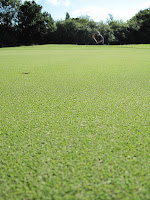 My key for a top greens' surface, or any playing surface to think of it is density. Creating tight, firm swards is crucial to producing top quality playing surfaces. To achieve this, on top of good cultural practises, I believe in a low cutting height and frequent spoon feeds at very low rates, just keeping the plant ticking along nicely. The tightest swards that I have seen with the greatest shoot density have been the modern creeping bents and the good old fashioned perennial poa (which incidentally is seen as a weed by certain traditionalists). Cut low, the swards get so tight on these surfaces that sometimes you have to verti-cut just to get a granular feed in to the canopy. Moss doesn't stand a chance of breaking into these swards.
My key for a top greens' surface, or any playing surface to think of it is density. Creating tight, firm swards is crucial to producing top quality playing surfaces. To achieve this, on top of good cultural practises, I believe in a low cutting height and frequent spoon feeds at very low rates, just keeping the plant ticking along nicely. The tightest swards that I have seen with the greatest shoot density have been the modern creeping bents and the good old fashioned perennial poa (which incidentally is seen as a weed by certain traditionalists). Cut low, the swards get so tight on these surfaces that sometimes you have to verti-cut just to get a granular feed in to the canopy. Moss doesn't stand a chance of breaking into these swards.We all now accept that the excessive fertility inputs of the past have no place in a modern maintenance programme as they produce soft, spongy, disease ridden surfaces that are terrible to putt on. But have today's turf managers gone too far the other way? In certain circumstances, I believe so. The heavy ammonia granular feeds of yesteryear may have produced carpet like swards and because they were so dense they did keep out the moss. However, to help gain speed on longer heights of cuts, fertility has been heavily reduced in certain turf programmes. This has produced weaker swards ideal for pests like moss to gain an advantage. This is where I think frequent spoon feeding has a place in a modern turf programme.
 With frequent, light rates, spoon feeding can give you a sward that is growing at a controlled rate. The advantages of this are increased speed and smoother ball roll as growth is controlled but, more importantly for moss control, a stronger sward that helps to suffocate this pest out.
With frequent, light rates, spoon feeding can give you a sward that is growing at a controlled rate. The advantages of this are increased speed and smoother ball roll as growth is controlled but, more importantly for moss control, a stronger sward that helps to suffocate this pest out.I don't assume that I have the total answer to the question of moss, but having thought about it over the past few months I ask you to consider that there may be a link between cutting heights and fertility. What goes without question is that the greater the sward density, the more chance you have of keeping moss at bay. If you have reduced your fertility over the last few years and seen a dramatic increase in moss, try upping the fertility levels again. It may be as simple as that!

No comments:
Post a Comment